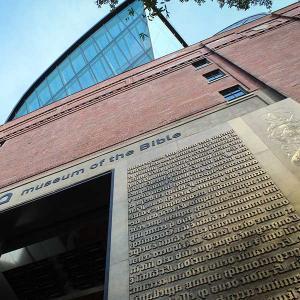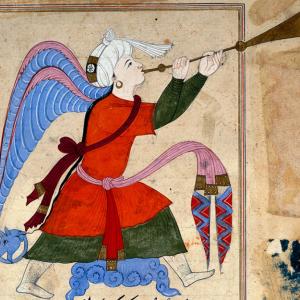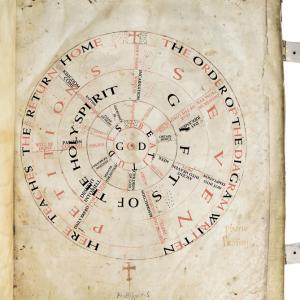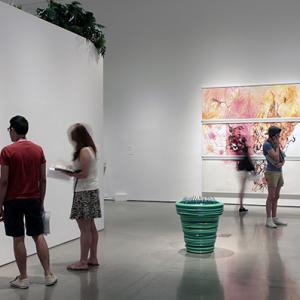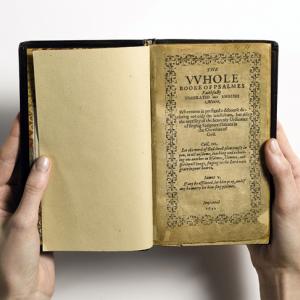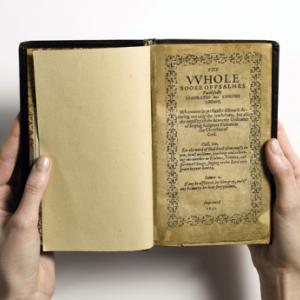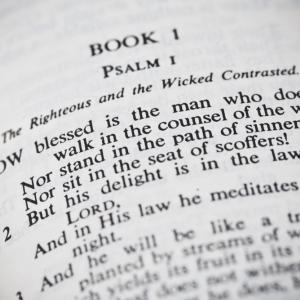David Van Biema is a correspondent for RNS.
Posts By This Author
The Green Family’s Other Collection
In October, Shaaban Abdel-Gawad, the head of the Reparations Department, confirmed that the case was under investigation. Representatives for both the Museum of the Bible and the Green Collection say they have no knowledge of Egypt’s initiative. But if it proceeds, a second international scandal could rock their world. (Asked how many Egyptian objects are in the Green Collection, a Hobby Lobby representative emailed: “I’m sorry. That’s not information that I’m able to provide.”)
Partnership with Martin Scorsese Gives This Evangelical Artist Wider Exposure
Today, Fujimura is the most successful serious artist of openly evangelical faith in the U.S., and probably in the world. His larger paintings sell for up to $400,000 and defy the secular art establishment’s unspoken commandment: Thou shalt not reward an artist who claims explicit Christian inspiration.
The City of Jerusalem Comes to the Met
In Jerusalem, Boehm said, there was a “very thin membrane” between the earthly and metaphysical.
That porousness is the origin of all the show’s marvelous art and of many of the city’s troubles, past and present. Almost lost on one wall of the show is a photograph of a glorious pulpit that stood in the Al-Aqsa Mosque from 1188 until 1969, when a delusional Australian torched it. He was trying to destroy the mosque so that the temple could be rebuilt to facilitate Jesus’ return.
Can Religious Art Be Taken Seriously Again?
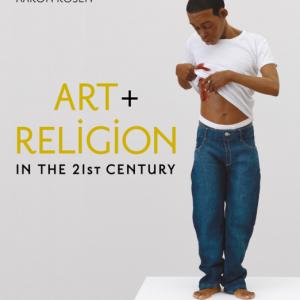
Image via Thames & Hudson / RNS
It is not easy to be a respected member of the art-world intelligentsia and take religion seriously.
“Religion and modern art continue to be typecast as mortal enemies,” writes Aaron Rosen.
No Dice Required: A Medieval Prayer Wheel Surfaces, but How It Was Used Is Anyone’s Guess
If much of life in the High Middle Ages seems foreign to us, the detailed workings of the wheel — along with four others like it that have survived to the present — are a real riddle.
Schematic prayer guides were more common in later centuries, said Lauren Mancia, a medievalist at Brooklyn College who has examined the Liesborn Wheel.
“Monks and nuns in the Central Middle Ages often get a bad rap for unsystematic thinking — doing all this prayer by rote, mumbling, and not caring about the sense,” said Mancia.
“This diagram suggests that they’re not just mumbling, they’re using a mnemonic device to remember and internalize, or even to make an inner journey.”
Citing Lack of Funding, New York’s Museum of Biblical Art to Close
On the heels of what seemed like its greatest triumph — a magnificent display of sculptures by the Renaissance pioneer Donatello — a small but important museum in midtown Manhattan, that specialized in religious art regarded with a neutrally secular eye, announced April 28 that it was going out of business.
A press release from the Museum of Biblical Art, known as MOBIA, explained that after learning in February that the American Bible Society, which had housed it for a decade, was selling its building and moving to Philadelphia, the museum explored multiple options but could not raise the funds needed to keep going at a new location.
The museum will close to the general public on June 14 and cease operations on the 30th, although an exhibit it co-organized on Spanish colonial religious art will open in Palm Beach, Fla., in March next year.
MOBIA’s fate was not a total surprise; The Bible Society, once MOBIA’s sole funder, had been ramping down its support by mutual agreement, and the sale of the building had been rumored since 2012. But the closing nonetheless deeply rattled the museum staff and those who treasured MOBIA as one of the few museums in the country that routinely acknowledged art’s religious context.
“I’m stunned,” said Dale T. Irvin, president of the New York Theological Seminary, who sometimes brought classes to MOBIA to see cross-cultural study of Scripture illustrated.
“I can’t believe that it’s slipping away. It was such a valuable resource.”
David Trobisch Lends Green Family’s Bible Museum a Scholarly Edge
In 2006, New Testament scholar David Trobisch abandoned such lofty outlets as Oxford Press and the Journal of Papyrology and Epigraphy for a more mainstream venue: Free Inquiry.
In that feisty secular humanist journal, Trobisch identified the likely editor of the New Testament as second-century Bishop Polycarp of Smyrna and suggested that Polycarp, not Luke, wrote much of the book of Acts.
Trobisch shared the magazine’s cover billing with Christopher Hitchens and the atheist animal rights theorist Peter Singer.
None of this would be unusual — serious New Testament scholars constantly probe its cloudy origins, wherever that leads — if Trobisch were not now prominently employed by one of the most famously conservative Christian families in America.
The Green family of Oklahoma City — the plaintiffs in the U.S. Supreme Court’s Hobby Lobby case — financed the 430,000-sqare-foot Museum of the Bible set to open in 2017 just off the National Mall in Washington.
It will showcase biblical artifacts from the 40,000-piece Green collection, one of the largest in private hands. As director of the collection, Trobisch does not run the museum (its director is Cary Summers), but in addition to enlarging, curating, and cataloging the trove, he participates in the crucial conversation about which items will go into the museum, and how.
‘Crown jewel’ of American Printing Fetches $14.2 Million in Record Auction
On a dark, damp and expensive Tuesday night at Sotheby’s auction house in Manhattan, one of the 11 surviving copies of the Bay Psalm Book, the first book (and the first book of Scripture) printed in English in America, was sold for the highest price ever recorded for a print book in open sale.
The $14.2 million price (a bid of $12.5 million, plus fees) exceeded by more than a million dollars the $11.5 million paid for the previous record-holder, John James Audubon’s “Birds of America,” in 2010.
The psalm book’s new owner is the private equity fund founder and philanthropist David Rubenstein, who called in his bid from Australia. According to Sotheby’s auctioneer David Redden, who gaveled down the sale in two and a half minutes of concerted bidding, Rubenstein, a well-known antiquities buyer and donator, intends to lend the ancient Puritan hymnal to libraries around the country, eventually putting it on long-term loan to one of them.
En Route to Sotheby’s, Bay Psalm Book Traces Nation’s Seesaw Religious History
Three hundred and seventy-three years ago, when the chief Puritan “divines” of the young Massachusetts Bay Colony printed their own translation of the Bible’s Book of Psalms, they prided themselves on importing the continent’s very first English printing press and establishing the colony as a cultural and educational center.
What they were certainly not anticipating — the little books sold for 20 pence apiece — was that next Tuesday, Sotheby’s will be auctioning off one of the 11 surviving copies of the Bay Psalter for between $10 and $30 million dollars. In that expected price range, it will be the most expensive book ever sold in public.
A Puritan might read this extraordinary markup as an example of God’s unknowable Providence. An economist might cite the laws of supply and demand. Either way, the blockbuster sale of “The Whole Book of Psalmes Faithfully Translated into English Meter” caps a fascinating seesaw act of American theology and marketplace. And depending on who wins the auction, it may say a bit more.
Mother Teresa As a Psalm
On Sept. 5, 1997, the world mourned when Mother Teresa, whose work with the poorest of the poor made her a global icon, died of a heart ailment at age 87.
Exactly 10 years later, the world did a double take, when a volume of Teresa's private letters revealed that the tireless, smiling nun spent the last 39 years of her life in internal agony. Jesus, she wrote, no longer seemed present to her, in prayer or even in the Eucharist. In letter after tormented letter she described an unrelenting spiritual "dryness,” a "torturing pain." Her smile was "a big cloak" of deception. She admitted at one point to doubting God's existence. Eventually she apparently became more reconciled to her condition; but as far as we know, she died with it.
One Psalm, Two Causes, Two Meanings
For decades, Psalm 139 has been a byword of the anti-abortion movement, printed on posters in crisis pregnancy centers. More recently, it's been tied to high-resolution ultrasounds, the movement's most potent technological persuader.
At the same time, the famous Psalm has also "come out" as a source of strength for gay and lesbian Christians.
Together, the two uses illustrate how great verses -- particularly the Psalms -- attract diverse constituencies.
